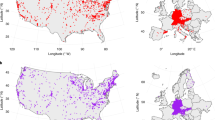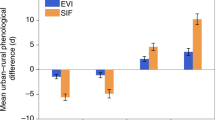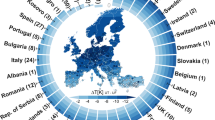Abstract
The modification of the surface radiation and energy balance in urban areas causes the temperatures in these areas to exceed those of the surrounding countryside. It has thus been suggested that urban environments may serve as field laboratories for studying the effects of a warming climate on biota in a space-for-time substitution. Here we investigated changes in the timing of plant phenology and temperature across study sites that differed in the degree of urbanization using publicly available pan-European datasets for the period 1981–2010. We found a significant advancement in the phenological phases of leaf development, flowering and fruiting with higher degrees of urbanization, whereas a significant delay was observed for phenological phases of leaf senescence. In addition to these phenological changes, an increase in air temperature with higher degrees of urbanization was observed. This increase was largest during the periods of leaf development, flowering and fruiting and smallest during the period of leaf senescence. On the basis of these results, we show that the apparent temperature sensitivity of phenological phases to urban warming is either significantly dampened (leaf development, flowering and fruiting) or reversed (leaf senescence) compared with the temperature sensitivity inferred from temporal changes in phenology and temperature. We conclude that gradients in urbanization represent a poor analogue for the temporal changes in plant phenology, apparently owing to confounding factors associated with urbanization.
This is a preview of subscription content, access via your institution
Access options
Access Nature and 54 other Nature Portfolio journals
Get Nature+, our best-value online-access subscription
$29.99 / 30 days
cancel any time
Subscribe to this journal
Receive 12 digital issues and online access to articles
$119.00 per year
only $9.92 per issue
Buy this article
- Purchase on Springer Link
- Instant access to full article PDF
Prices may be subject to local taxes which are calculated during checkout




Similar content being viewed by others
Data availability
The phenological data used in this study are available from www.pep725.eu and the air temperature data from www.ecad.eu. The data underlying the CORINE land cover, the imperviousness degree and the European settlement map are available from the Copernicus Land Monitoring Service (https://land.copernicus.eu/pan-european).
Code availability
The MATLAB (MathWorks) scripts used to analyse data are available at https://doi.org/10.5281/zenodo.3422079.
References
Cleland, E. E., Chuine, I., Menzel, A., Mooney, H. A. & Schwartz, M. D. Shifting plant phenology in response to global change. Trends Ecol. Evol. 22, 357–365 (2007).
Zhou, B., Rybski, D. & Kropp, J. P. On the statistics of urban heat island intensity. Geophys. Res. Lett. 40, 5486–5491 (2013).
Stewart, I. D. & Oke, T. R. Local climate zones for urban temperature. Stud. Bull. Am. Meteorol. Soc. 93, 1879–1900 (2012).
Jochner, S. & Menzel, A. Urban phenological studies—past, present, future. Environ. Pollut. 203, 250–261 (2015).
Neil, K. & Wu, J. Effects of urbanization on plant flowering phenology: a review. Urban Ecosyst. 9, 243–257 (2006).
Menzel, A. et al. European phenological response to climate change matches the warming pattern. Glob. Change Biol. 12, 1969–1976 (2006).
Harrison, T., Winfree, R. & Evans, K. Urban drivers of plant–pollinator interactions. Funct. Ecol. 29, 879–888 (2015).
Zhao, S., Liu, S. & Zhou, D. Prevalent vegetation growth enhancement in urban environment. Proc. Natl Acad. Sci. USA 113, 6313–6318 (2016).
Wang, S. et al. Urban–rural gradients reveal joint control of elevated CO2 and temperature on extended photosynthetic seasons. Nat. Ecol. Evol. 3, 1076–1085 (2019).
Herrmann, D. L., Schifman, L. A. & Shuster, W. D. Widespread loss of intermediate soil horizons in urban landscapes. Proc. Natl Acad. Sci. USA 115, 6751–6755 (2018).
Zipper, S. C., Schatz, J., Kucharik, C. J. & Loheide, S. P. Urban heat island-induced increases in evapotranspirative demand. Geophys. Res. Lett. 44, 873–881 (2017).
Mitchell, L. E. et al. Long-term urban carbon dioxide observations reveal spatial and temporal dynamics related to urban characteristics and growth. Proc. Natl Acad. Sci. USA 115, 2912–2917 (2018).
Grange, S. K., Lewis, A. C., Moller, S. J. & Carslaw, D. C. Lower vehicular primary emissions of NO2 in Europe than assumed in policy projections. Nat. Geosci. 10, 914–918 (2017).
Tsai, D. H., Wang, J. L., Wang, C. H. & Chan, C. C. A study of ground-level ozone pollution, ozone precursors and subtropical meteorological conditions in central Taiwan. J. Environ. Monit. 10, 109–118 (2008).
Jochner, S. et al. The effects of short- and long-term air pollutants on plant phenology and leaf characteristics. Environ. Pollut. 206, 382–389 (2015).
Honour, S. L., Bell, J. N., Ashenden, T. W., Cape, J. N. & Power, S. A. Responses of herbaceous plants to urban air pollution: effects on growth, phenology and leaf surface characteristics. Environ. Pollut. 157, 1279–1286 (2009).
Sanz, J. et al. Plant phenology, growth and nutritive quality of Briza maxima: responses induced by enhanced ozone atmospheric levels and nitrogen enrichment. Environ. Pollut. 159, 423–430 (2011).
Škvareninová, J. et al. Effects of light pollution on tree phenology in the urban environment. Morav. Geogr. Rep. 25, 282–290 (2017).
Massetti, L. Assessing the impact of street lighting on Platanus x acerifolia phenology. Urban For. Urban Green. 34, 71–77 (2018).
Gorton, A. J., Moeller, D. A. & Tiffin, P. Little plant, big city: a test of adaptation to urban environments in common ragweed (Ambrosia artemisiifolia). Proc. R. Soc. B 285, 20180968 (2018).
Stewart, I. D. A systematic review and scientific critique of methodology in modern urban heat island literature. Int. J. Climatol. 31, 200–217 (2011).
Comber, A. & Brunsdon, C. A spatial analysis of plant phenophase changes and the impact of increases in urban land use. Int. J. Climatol. 35, 972–980 (2015).
Jochner, S. C., Sparks, T. H., Estrella, N. & Menzel, A. The influence of altitude and urbanisation on trends and mean dates in phenology (1980–2009). Int J. Biometeorol. 56, 387–394 (2012).
Roetzer, T., Wittenzeller, M., Haeckel, H. & Nekovar, J. Phenology in central Europe – differences and trends of spring phenophases in urban and rural areas. Int J. Biometeorol. 44, 60–66 (2000).
Templ, B. et al. Pan European Phenological database (PEP725): a single point of access for European data. Int J. Biometeorol. 62, 1109–1113 (2018).
Klein Tank, A. M. G. et al. Daily dataset of 20th-century surface air temperature and precipitation series for the European Climate Assessment. Int. J. Climatol. 22, 1441–1453 (2002).
Chrysanthou, A., van der Schrier, G., van den Besselaar, E. J. M., Klein Tank, A. M. G. & Brandsma, T. The effects of urbanization on the rise of the European temperature since 1960. Geophys. Res. Lett. 41, 7716–7722 (2014).
Keenan, T. F., Richardson, A. D. & Hufkens, K. On quantifying the apparent temperature sensitivity of plant phenology. New Phytol. https://doi.org/10.1111/nph.16114 (2019).
van Hove, L. W. A. et al. Temporal and spatial variability of urban heat island and thermal comfort within the Rotterdam agglomeration. Build. Environ. 83, 91–103 (2015).
Peterson, T. C. & Owen, T. W. Urban heat island assessment: metadata are important. J. Clim. 18, 2637–2646 (2005).
Zhou, Y. et al. A global map of urban extent from nightlights. Environ. Res. Lett. 10, 054011 (2015).
Meier, U. in Phenology: An Integrative Environmental Science (ed. Schwartz, M. D.) 269–283 (Kluwer Academic, 2003).
Fu, Y. H. et al. Declining global warming effects on the phenology of spring leaf unfolding. Nature 526, 104–107 (2015).
Acknowledgements
Phenological data were provided by the members of the PEP725 project. We acknowledge the air temperature data providers of the ECA&D project. This work was partially supported through a grant by the Austrian National Science Fund (FWF, grant number FP27176-B16).
Author information
Authors and Affiliations
Contributions
G.W. conceived the study, analysed the data and wrote the manuscript together with E.T. and A.H.
Corresponding author
Ethics declarations
Competing interests
The authors declare no competing interests.
Additional information
Publisher’s note Springer Nature remains neutral with regard to jurisdictional claims in published maps and institutional affiliations.
Supplementary information
Supplementary Information
Supplementary Figs. 1–12 including figure legends.
Rights and permissions
About this article
Cite this article
Wohlfahrt, G., Tomelleri, E. & Hammerle, A. The urban imprint on plant phenology. Nat Ecol Evol 3, 1668–1674 (2019). https://doi.org/10.1038/s41559-019-1017-9
Received:
Accepted:
Published:
Issue Date:
DOI: https://doi.org/10.1038/s41559-019-1017-9
This article is cited by
-
Assessing urban-heating impact on street tree growth in Berlin with open inventory and environmental data
Urban Ecosystems (2024)
-
Different phenological behaviour of native and exotic grasses extends the period of pollen exposure with clinical implications in the Madrid Region, Spain
Biological Invasions (2024)
-
Putting conservation gardening into practice
Scientific Reports (2023)
-
Phenology of grassland plants responds to urbanization
Urban Ecosystems (2023)
-
Advances in spring leaf phenology are mainly triggered by elevated temperature along the rural-urban gradient in Beijing, China
International Journal of Biometeorology (2023)



